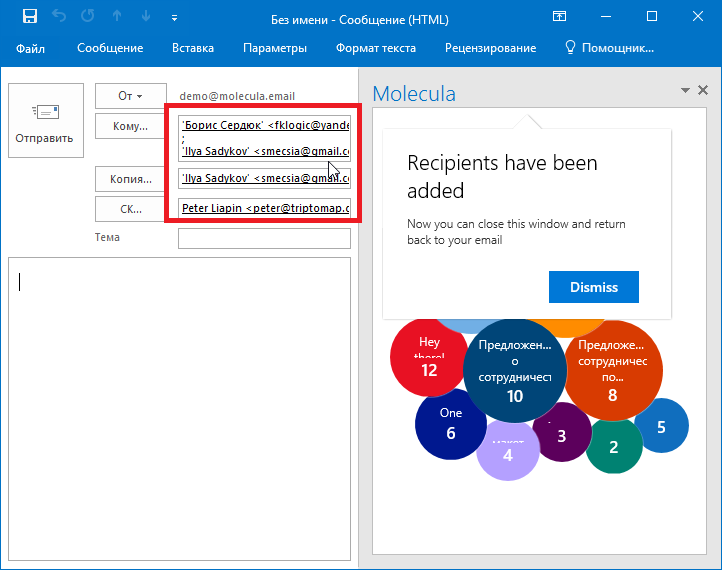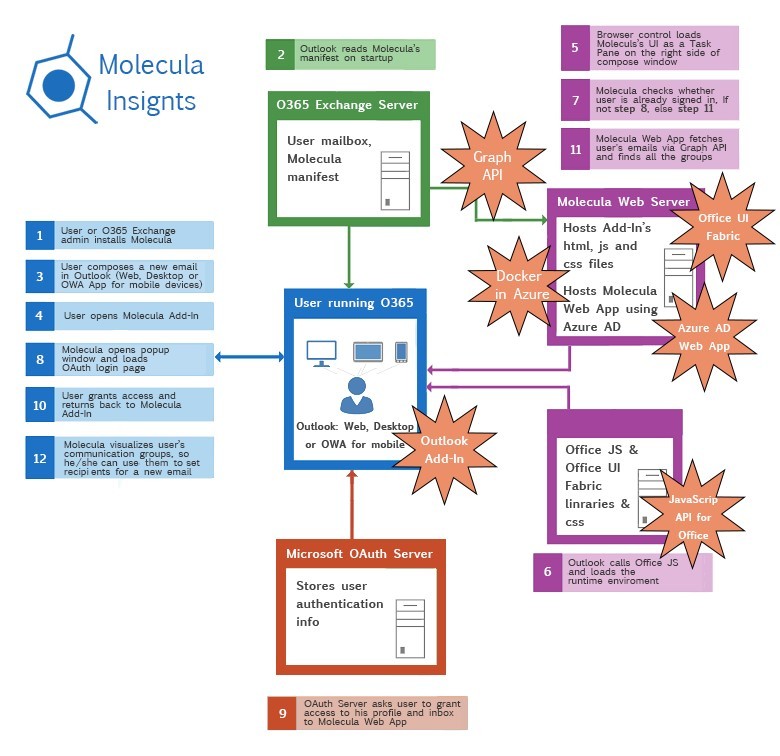Molecula - a new way to conduct group correspondence in Outlook
At the end of 2015, Microsoft launched the Office 365 solution design competition. Participants needed to develop an application that would either be an add-in for Office or use the Office 365 APIs . I and my two friends decided to participate. The idea was found very quickly, it was enough to sit down and discuss the "pains" that arise in each of us in our daily work. So the idea was born Molecula - solutions to simplify the management of group correspondence in Outlook .
To better understand who and why Molecula is needed, let's see our promotional video created for the contest. The story about the successful IT manager Mike (in English):
We constantly have to correspond by email with different groups of people. Each group corresponds to a specific topic, whether it is one of the projects, discussion of work issues with employees from other departments, communication with partners, customers, etc. When there is a need to write a new letter to a particular group of people, you have to look for old letters in history and copy all the participants in the correspondence into a new letter in manual mode. It takes a lot of time! Even worse, when you need to write to several groups that participated in many correspondences. As an example - to send a happy new year greetings to all employees of the customer with whom you spoke during the year. In manual mode, you can easily overlook someone important. The Molecula project is designed to solve this problem.
')
Molecula indexes all letters from an account in Office 365 and groups correspondence participants using a special algorithm. The resulting groups are presented to the user in the form of visual "bubbles", large of which represent groups of people with whom the user communicates most often:

To write a new letter, just click on the desired “bubble” and specify which recipients will be in the TO , CC and BSC fields (by dragging contacts from one group to another):

Click the "Set Recipients" button and that's it - the recipients are set! No more rummaging through the mail in search of old letters!

In MVP, we developed an Outlook Add-Id and a Web application using Azure AD . When developing the Outlook Add-In, the JavaScript API for Outlook and the new UI framework from Microsoft, Office UI Fabric, were used . The d3js library was used to visualize the bubbles.
The server part is implemented using Java and Docker containers. The server itself is deployed in Azure, and the Microsoft Graph API is used to receive emails from Office 365.
More clearly, the system architecture is shown in the figure below.

It took a lot of time to learn the logic of setting up the Graph API in Azure and visualizing the “bubbles” as we originally wanted it. Debugging was done under OWA for iPhone with big problems - a separate article will be released soon.
Now we are working on publishing the first version of the Molecula Add-In in the Office Store and we expect that by mid-April, the add-in can be installed directly from the Office store. You can play around with the web version today by clicking on the link below. Please note that for testing you need an account with a subscription to Office 365 .
Link to the Web version of Molecula: https://molecula.email/web
As I wrote above, the first version of Molecula is MVP (minimally useful product). In the second version we plan:
Further development will be planned, starting from the wishes of users. If Molecula solves a problem that is true for you - write about it in the comments! Tell us what else you would like to see in Molecula?
Like the idea? Support Molecula with your voice at DevPost (voting may require registration, takes no more than 3 minutes).

Peter Lyapin - Technical Director of Wave Point Ltd.
More than 10 years of experience in implementing automation projects
business processes. Worked with many Russian and
foreign companies. Founder of the XLTools.net project.
To better understand who and why Molecula is needed, let's see our promotional video created for the contest. The story about the successful IT manager Mike (in English):
Problematics
We constantly have to correspond by email with different groups of people. Each group corresponds to a specific topic, whether it is one of the projects, discussion of work issues with employees from other departments, communication with partners, customers, etc. When there is a need to write a new letter to a particular group of people, you have to look for old letters in history and copy all the participants in the correspondence into a new letter in manual mode. It takes a lot of time! Even worse, when you need to write to several groups that participated in many correspondences. As an example - to send a happy new year greetings to all employees of the customer with whom you spoke during the year. In manual mode, you can easily overlook someone important. The Molecula project is designed to solve this problem.
')
How does Molecula work
Molecula indexes all letters from an account in Office 365 and groups correspondence participants using a special algorithm. The resulting groups are presented to the user in the form of visual "bubbles", large of which represent groups of people with whom the user communicates most often:

To write a new letter, just click on the desired “bubble” and specify which recipients will be in the TO , CC and BSC fields (by dragging contacts from one group to another):

Click the "Set Recipients" button and that's it - the recipients are set! No more rummaging through the mail in search of old letters!

Solution Architecture
In MVP, we developed an Outlook Add-Id and a Web application using Azure AD . When developing the Outlook Add-In, the JavaScript API for Outlook and the new UI framework from Microsoft, Office UI Fabric, were used . The d3js library was used to visualize the bubbles.
The server part is implemented using Java and Docker containers. The server itself is deployed in Azure, and the Microsoft Graph API is used to receive emails from Office 365.
More clearly, the system architecture is shown in the figure below.

Problems we encountered while developing
It took a lot of time to learn the logic of setting up the Graph API in Azure and visualizing the “bubbles” as we originally wanted it. Debugging was done under OWA for iPhone with big problems - a separate article will be released soon.
How to try
Now we are working on publishing the first version of the Molecula Add-In in the Office Store and we expect that by mid-April, the add-in can be installed directly from the Office store. You can play around with the web version today by clicking on the link below. Please note that for testing you need an account with a subscription to Office 365 .
Link to the Web version of Molecula: https://molecula.email/web
Future plans
As I wrote above, the first version of Molecula is MVP (minimally useful product). In the second version we plan:
- improve the recipient grouping algorithm;
- provide the user with an alternative way to visualize groups, allowing you to display a larger number of groups on one screen with the option of contextual search across all groups
- There are ideas for integrating groups from Molecula with standard group functionality in Outlook (while it is being worked out).
Further development will be planned, starting from the wishes of users. If Molecula solves a problem that is true for you - write about it in the comments! Tell us what else you would like to see in Molecula?
Like the idea? Support Molecula with your voice at DevPost (voting may require registration, takes no more than 3 minutes).

about the author
Peter Lyapin - Technical Director of Wave Point Ltd.
More than 10 years of experience in implementing automation projects
business processes. Worked with many Russian and
foreign companies. Founder of the XLTools.net project.
Source: https://habr.com/ru/post/279307/
All Articles